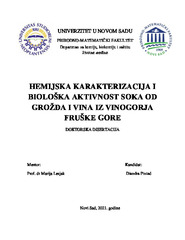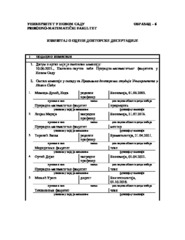Приказ основних података о дисертацији
Hemijska karakterizacija i biološka aktivnost soka od grožđa i vina iz vinogorja Fruške gore
Chemical characterization and biological activity of grape juice and wine from the vineyards of Fruška Gora
| dc.contributor.advisor | Lesjak, Marija | |
| dc.contributor.other | Mimica-Dukić, Neda | |
| dc.contributor.other | Lesjak, Marija | |
| dc.contributor.other | Torović, LJilja | |
| dc.contributor.other | Orčić, Dejan | |
| dc.contributor.other | Miljić, Uroš | |
| dc.creator | Пинтаћ, Диандра | |
| dc.date.accessioned | 2021-09-28T09:09:03Z | |
| dc.date.available | 2021-09-28T09:09:03Z | |
| dc.date.issued | 2021-09-21 | |
| dc.identifier.uri | https://www.cris.uns.ac.rs/DownloadFileServlet/Disertacija162608626466387.pdf?controlNumber=(BISIS)117956&fileName=162608626466387.pdf&id=18030&source=NaRDuS&language=sr | sr |
| dc.identifier.uri | https://www.cris.uns.ac.rs/record.jsf?recordId=117956&source=NaRDuS&language=sr | sr |
| dc.identifier.uri | https://www.cris.uns.ac.rs/DownloadFileServlet/IzvestajKomisije162608627512062.pdf?controlNumber=(BISIS)117956&fileName=162608627512062.pdf&id=18031&source=NaRDuS&language=sr | sr |
| dc.identifier.uri | https://nardus.mpn.gov.rs/handle/123456789/18538 | |
| dc.description.abstract | Vino zauzima značajno mesto u tradiciji i istoriji mnogih zemalja širom sveta. Nakon internacionalne Studije Sedam Zemalja (The Seven Countries Study), projekta Svetske zdravstvene organizacije (MONICA) i definisanja Francuskog paradoksa, gde je istaknuto da vino može ispoljiti kardioprotektivno dejstvo, sve više se radi na otkrivanju i ostalih blagotvornih efekata vina na ljudsko zdravlje. Budući da su fruškogorska vina veoma popularna i cenjena, postoji velika potreba za njihovom karakterizacijom u smislu utvrđivanja njihovog hemijskog sastava i biološkog potencijala, što do sada još uvek nije učinjeno. U okviru ove doktorske disertacije, sakupljeni su sokovi i vina tri uzastopne berbe iz istih vinograda (ukupno 56 uzoraka) i komercijalno dostupna fruškogorska vina napravljena od pojedinačnih sorti, kao i nekoliko kupažiranih vina (91 uzorak). Utvrđen je detaljan polifenolni sastav svih uzoraka uz pomoć spektrofotometrijskih, LCMS-MS i LC-UV-vis metoda. Biohemijska istraživanja su obuhvatila određivanje antioksidantne (kroz 6 testova), neuroprotektivne (kroz inhibiciju enzima acetilholin esteraze) i antiinflamatorne aktivnosti (praćenjem smanjenja produkcije određenih medijatora inflamacije ciklooksigenaznog i lipooksigenaznog puta). Prvi cilj ove doktorske disertacije je bio da se odredi koliko se međusobno razlikuju sok i vino u pogledu polifenolnog sastava i biološke aktivnosti i koliko variraju ovi parametri u periodu od tri godine. Rezultati su potvrdili da vino generalno karakteriše veći sadržaj svih ispitivanih polifenola, osim grupe flavonola (kemferol-3-Oglukozid, kvercetin-3-O-glukozid i hiperozid), kojima su sokovi bili bogatiji. U nekoliko biohemijskih testova sokovi su ispoljili bolju aktivnost od vina, što je veoma značajno budući da je sok bezalkoholno piće i može da ima širu primenu nezavisno od uzrasta. Značajne varijacije su se javile u poređenju uzoraka kroz trogodišnji period usled promene klimatskih faktora i zbog razlika u tehnološkom procesu proizvodnje vina. Drugi cilj je bio određivanje fenolnog profila i biološke aktivnosti vina internacionalnih, autohtonih i domaćih novonastalih sorti fruškogorskog podneblja. Analize su pokazale da većinu vina fruškogorskih vinograda karakteriše veći sadržaj epikatehina i nekoliko fenolnih kiselina, kao što su siringinska, 2,5-dihidroksibenzoeva, kafena i p-kumarinska kiselina, u poređenju sa literaturnim podacima za vina određenih sorti i regija Francuske, Španije, Hrvatske, Kine, južne Afrike, Brazila i Argentine. Dat je pregled jedinjenja koja karakterišu vina od pojedinačnih sorti, a takođe je izvršena i diferencijacija u zavisnosti od lokaliteta vinograda iz kojih je poteklo grožđe za ove oglede. Po biološkoj aktivnosti, fruškogorska vina su bila u rangu svetskih vina, a naročito su se istakla vina sorti Frankovka, Probus, Portugizer, Župljanka, Sila i Petra, koja su bila bolja od internacionalnih sorti gajenih na Fruškoj gori što doatno doprinosi njihovoj afirmaciji kako u domaćoj, tako i u međunarodnoj vinskoj industriji. Pokazano je da viša cena vina ne garantuje bolji zdravstveni benefit i bogatiji fenolni sastav. Rezultati iz ove teze predstavljaju značajan doprinos naučnoj literaturi i pružaju podatke o polifenolnom sastavu i biološkoj aktivnosti fruškogorskih vina i sokova od grožđa, kojih do sada ima jako malo. | sr |
| dc.description.abstract | Wine is a part of the tradition and history of many countries in the world. After The Seven Countries Study, MONICA project of the World Health Organization and defining the French paradox, that have shown a clear link between wine and its cardioprotective properties, numerous studies focused on researching other healthful benefits of wine. Since there is very little information regarding wines from Fruška Gora, that are well known and have a long tradition, there is a need for their chemical and biochemical characterization. For the purpose of this doctoral dissertation, grape juices and wines were taken from the same vineyards in a three year period (a total amount of 56 samples), and commercially available wines from Fruška Gora consisting of one variety and a few blended wines were bought (a total amount of 91 samples). A detailed polyphenolic profile of all samples was determined using spectrophotometric, LC-MS-MS and LC-UV-vis methods. Assessed biological activities included antioxidant (using 6 assays), neuroprotective (inhibition of acetylcholinesterase) and anti-inflammatory activity (following a decrease in the production of inflammatory mediators of the cyclooxygenase and lipoxygenase pathways). The first aim of this thesis was to define the differences in the polyphenolic composition and biological activity between grape juices and wines, and the variations of these parameters during three years. Results have confirmed that the wines contain a higher amount of all tested phenolic compounds, compared to juices, with the exception of the flavonol group (kaemepferol 3-O-glucoside, quercetin 3-O-glucoside and hyperoside) that was more abundant in grape juices. Grape juices showed an equally good or even a better activity than corresponding wines in some of the biological assays which is very significant since the juice is alcohol free and can be consumed by everyone regardless the age limits. Comparing obtained results for the three year period, greater variations were noticed and explained by changes in the climatic factors and technological processes. The second aim was to characterize and compare wines from the region of Fruška Gora made from international, autochtonous and domestic varieties. Obtained results pointed out compounds epicatechin and a few phenolic acids such as syrngic, 2,5-dihydroxybenzoic, caffeic and p-coumaric acids as features of wines from Fruška Gora region, when compared to literature data concerning wines of different varieties and regions in France, Spain, Croatia, China, South Africa, Brazil and Argentina. Compounds that characterize wines of single varieties, as well as wines originating from different vineyards were specified. Considering biological activity, wines from Fruška Gora were in the same range as international wines. Varieties that characterize vineyards of Fruška Gora such as Frankovka, Probus, Portugizer, Župljanka, Sila and Petra showed a better activity compared to international varieties, which can contribute to their affirmation on the domestic and international wine industry. It was also shown that a higher wine price does not guarantee better health benefits and richer polyphenolic content. Results obtained in this dissertation present a significant contribution to scientific literature that lacks information on Fruška Gora wines and grape juices, providing information on the polyphenolic content and biological activity of grapevine products of this well known wine region. | en |
| dc.language | sr (latin script) | |
| dc.publisher | Универзитет у Новом Саду, Природно-математички факултет | sr |
| dc.rights | openAccess | en |
| dc.rights.uri | https://creativecommons.org/licenses/by-nc-nd/4.0/ | |
| dc.source | Универзитет у Новом Саду | sr |
| dc.subject | Vitis vinifera L. | sr |
| dc.subject | Vitis vinifera L. | en |
| dc.subject | vinova loza | sr |
| dc.subject | sok od grožđa | sr |
| dc.subject | vino | sr |
| dc.subject | Fruška gora | sr |
| dc.subject | antioksidantna aktivnost | sr |
| dc.subject | europrotektivna aktivnost | sr |
| dc.subject | inhibicija acetilholin esteraze | sr |
| dc.subject | antiinflamatorna aktivnost | sr |
| dc.subject | polifenoli | sr |
| dc.subject | flavonoidi | sr |
| dc.subject | antocijani | sr |
| dc.subject | tanini | sr |
| dc.subject | odnos cena-kvalitet | sr |
| dc.subject | grapevine | en |
| dc.subject | grape juice | en |
| dc.subject | wine | en |
| dc.subject | Fruška Gora | en |
| dc.subject | antioxidant activity | en |
| dc.subject | europrotective activity | en |
| dc.subject | inhibition of acetylcholinesterase | en |
| dc.subject | tiinflammatory activity | en |
| dc.subject | polyphenols | en |
| dc.subject | flavonoids | en |
| dc.subject | anthocyanins | en |
| dc.subject | tannins | en |
| dc.subject | pricequality relation | en |
| dc.title | Hemijska karakterizacija i biološka aktivnost soka od grožđa i vina iz vinogorja Fruške gore | sr |
| dc.title.alternative | Chemical characterization and biological activity of grape juice and wine from the vineyards of Fruška Gora | en |
| dc.type | doctoralThesis | sr |
| dc.rights.license | BY-NC-ND | |
| dcterms.abstract | Лесјак, Марија; Орчић, Дејан; Миљић, Урош; Мимица-Дукић, Неда; Лесјак, Марија; Торовић, ЛЈиља; Pintać, Diandra; Хемијска карактеризација и биолошка активност сока од грожђа и вина из виногорја Фрушке горе; Хемијска карактеризација и биолошка активност сока од грожђа и вина из виногорја Фрушке горе; | |
| dc.identifier.fulltext | https://nardus.mpn.gov.rs/bitstream/id/76307/Disertacija_11488.pdf | |
| dc.identifier.fulltext | https://nardus.mpn.gov.rs/bitstream/id/76308/Izvestaj_komisije_11488.pdf | |
| dc.identifier.rcub | https://hdl.handle.net/21.15107/rcub_nardus_18538 |



